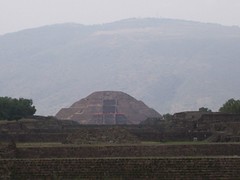Teotihuacan, Toltecs, and Aztecs
By rfay - Posted on May 7th, 2007
Tagged: Inuvik to Ushuaia
We have now arrived in the land of phenomenal Meso-American cultures, and will find can't-pass-it-by ruins for the next few months. Our final approach to the north of Mexico City took us right up to two major archaeological sites, Tula and Teotihuacan. Then, smack in the middle of Mexico City are the ruins of the main temple of the Aztecs. We visited Tula first, then Teotihuacan and the Templo Mayor, but I'll describe them in their order, rather than ours.
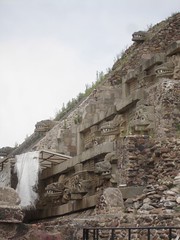
Temple of Quezlcoatl at Teotihuacan
Teotihuacan (Tay-Oh-Tee-Wah-Kahn) was probably the first major city (and certainly the first planned city) in Meso-America. Starting about 150 A.D. and surviving until about 750 A.D., the people of Teotihuacan built an incredible complex and a very robust civilization. The striking things for visitors are the Temples of the Sun and Moon. The Temple of the Sun is the 3rd largest pyramid in the world. I climbed both; Nancy had a pulled muscle and deferred. The sheer size of the site and its pyramids are what drives visitors from all over the world to spend a day there. And all later Meso-American societies regarded Teotihuacan as a holy and amazing place. The Aztecs went there for special religious occasions and believed that the gods created the place and then sacrificed themselves there to begin the world as they knew it.
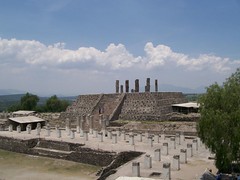
Tula Pyramid with Atlantes
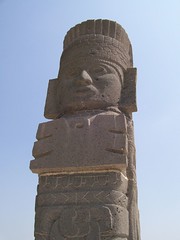
Atlantes Closeup - Tula
Tula, the ancient capital of the Toltecs, came after Teotihuacan, probably from about 900-1150 A.D. (It's about 1 day's bike ride - about 55 miles/90 km to the west.) The Toltecs also inherited much of the culture of Teotihuacan and considered it a holy place. The modest-sized pyramid at Tula has amazing "Atlantes" that held up the temple roof, carved warrior pillars.
The Templo Mayor has the least remaining structures of the three, but is tremendously interesting. The Aztecs (or Mexica) arrived at the current site of the very center of Mexico City in 1325 after multi-century pilgrimmage in which they were looking for their place, the center of the universe. They found it one day when the prophesied "eagle sitting on a cactus eating a snake" was sighted. They stopped right there and built one of the most extensive empires of the pre-Hispanic Americas. Their temple, the Templo Mayor, was an imposing pyramid that stood over the city and the lake that is now the rest of Mexico City.
When Cortes and the Spanish Conquistadores arrived, they ordered all the religious sites and most of the religious objects and writings destroyed. The Templo Mayor was razed, and the Spanish built their cathedral and headquarters on top of it. What they didn't know was that there were two centuries of smaller pyramids underneath it, as the Aztecs had continually enlarged the pyramid. So in 1979 when some street maintenance workers found a huge Aztec relic, the decision was made to excavate the entire site, even though it meant tearing up a piece of the very center of Mexico's downtown.
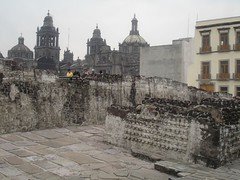
Mexico City Cathedral the Templo Mayor
The archeologists found a whole series of pyramids-within-pyramids, where the Aztecs had enlarged by adding on new layers. And inside it all were hundreds and hundreds of offerings, including human remains and trade goods from all over the Meso-American world, and even antiques from ancient Teotihuacan.
The offerings, of course, are hard to talk about. Apparently most of the Meso-American cultures, including Teotihuacan, the Toltecs, and the Mayas, did human sacrifices. But the Aztecs were completely psychotic about it, if I can say that without hurting anybody's feelings.
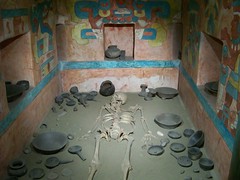
Templo Mayor Offering
They believed that they were the Sun people, entrusted with the welfare of the sun, and if they didn't keep the human sacrifices going, the sun wouldn't come up in the morning. So they sacrificed, daily, and in increasing numbers as their power increased. As they dominated all the cultures in the region, they required not just enormous amounts of trade goods, but also enormous numbers of prisoners for sacrifice, and the blood from the sacrifices ran in the streets. These sacrifices and many others are what were found in the Templo Mayor.

Temple of Quezlcoatl at Teotihuacan

Tula Pyramid with Atlantes

Atlantes Closeup - Tula
The Templo Mayor has the least remaining structures of the three, but is tremendously interesting. The Aztecs (or Mexica) arrived at the current site of the very center of Mexico City in 1325 after multi-century pilgrimmage in which they were looking for their place, the center of the universe. They found it one day when the prophesied "eagle sitting on a cactus eating a snake" was sighted. They stopped right there and built one of the most extensive empires of the pre-Hispanic Americas. Their temple, the Templo Mayor, was an imposing pyramid that stood over the city and the lake that is now the rest of Mexico City.
When Cortes and the Spanish Conquistadores arrived, they ordered all the religious sites and most of the religious objects and writings destroyed. The Templo Mayor was razed, and the Spanish built their cathedral and headquarters on top of it. What they didn't know was that there were two centuries of smaller pyramids underneath it, as the Aztecs had continually enlarged the pyramid. So in 1979 when some street maintenance workers found a huge Aztec relic, the decision was made to excavate the entire site, even though it meant tearing up a piece of the very center of Mexico's downtown.

Mexico City Cathedral the Templo Mayor
The archeologists found a whole series of pyramids-within-pyramids, where the Aztecs had enlarged by adding on new layers. And inside it all were hundreds and hundreds of offerings, including human remains and trade goods from all over the Meso-American world, and even antiques from ancient Teotihuacan.
The offerings, of course, are hard to talk about. Apparently most of the Meso-American cultures, including Teotihuacan, the Toltecs, and the Mayas, did human sacrifices. But the Aztecs were completely psychotic about it, if I can say that without hurting anybody's feelings.

Templo Mayor Offering

